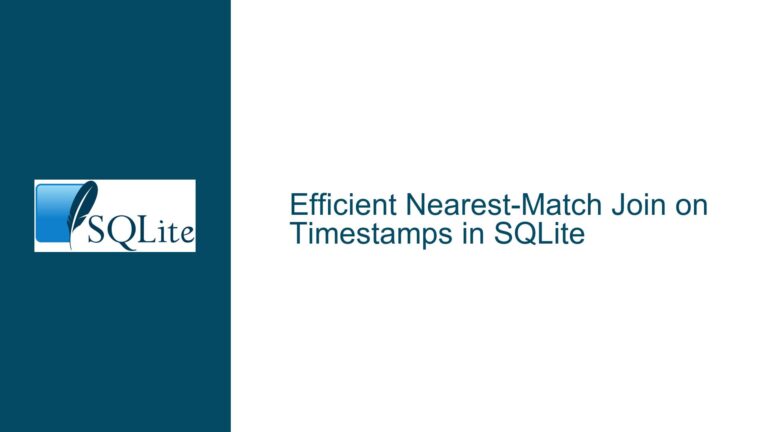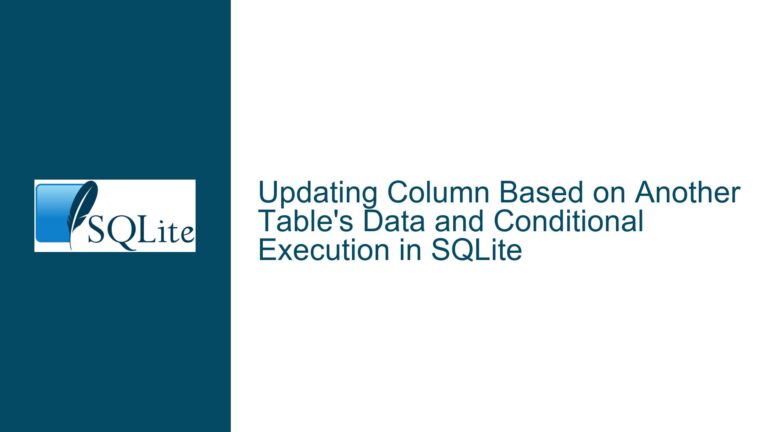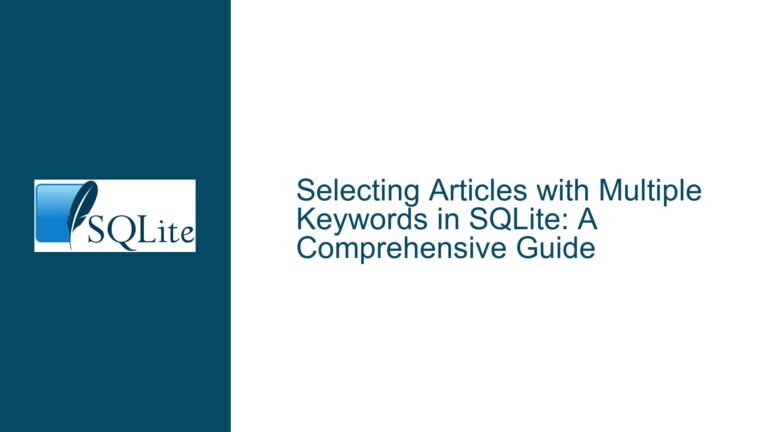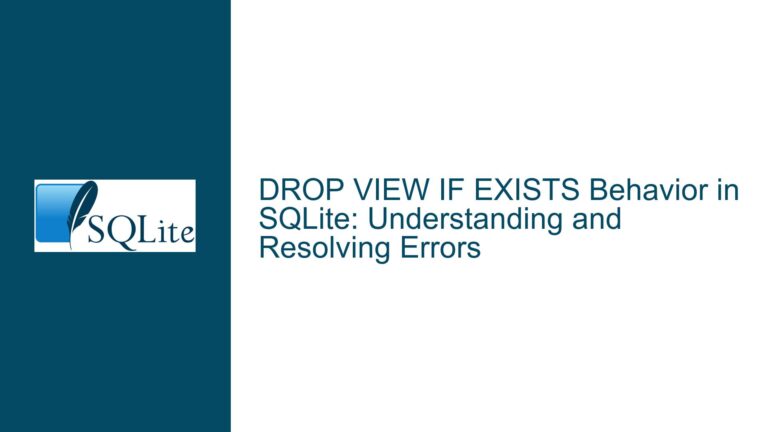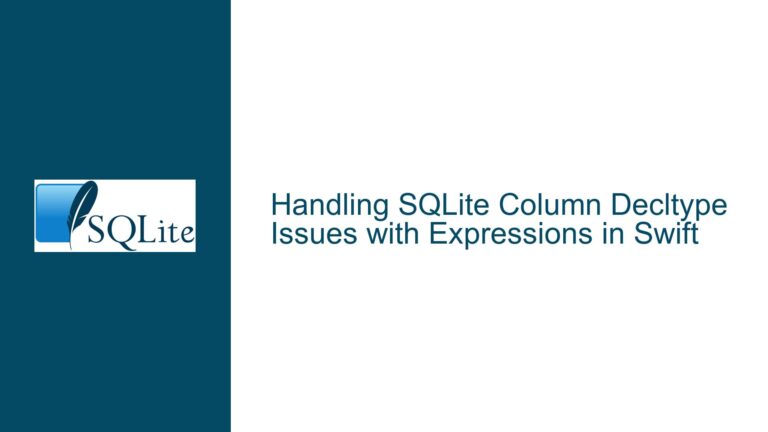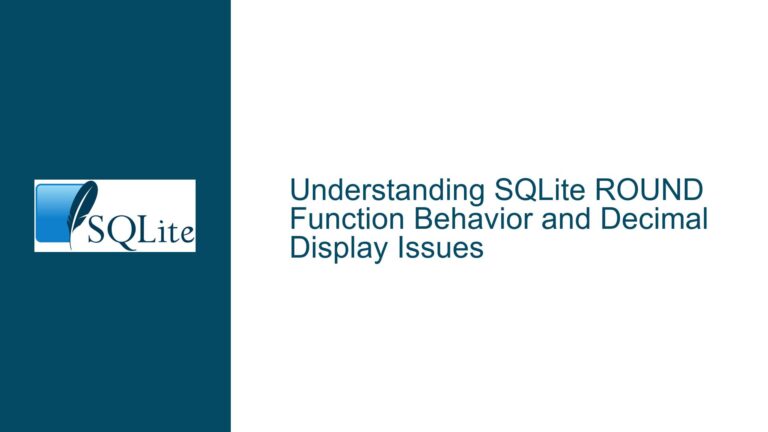SQLite round() Function Returns Float Instead of Integer: Expectations vs. Behavior
Issue Overview: SQLite’s round() Function Returns Floating-Point Values for Zero-Decimal Rounds
The core issue revolves around the behavior of SQLite’s round() function when rounding numeric values to zero decimal places. Users familiar with other database systems, such as PostgreSQL, may expect round(1.2, 0) to return an integer value (e.g., 1), but SQLite instead returns a floating-point value (e.g., 1.0). This discrepancy arises from SQLite’s type affinity system, its storage classes, and the internal implementation of the round() function. Unlike PostgreSQL, which distinguishes between NUMERIC, INTEGER, and FLOAT types with specific rounding semantics, SQLite treats all numeric values as either INTEGER or REAL (floating-point) storage classes. The round() function in SQLite explicitly returns a REAL value, even when rounding to zero decimal places. This behavior is consistent with SQLite’s documentation but conflicts with user expectations shaped by other database systems.
The confusion is compounded by the way SQLite’s command-line shell and other tools display values. For example, the shell renders 1.0 as a floating-point value, whereas 1 is displayed as an integer. However, in SQLite’s type system, these distinctions are less rigid due to dynamic typing. The round() function’s output adheres strictly to returning a REAL type, which preserves the decimal component even when it is zero. This design choice ensures consistency across all rounding operations but creates friction for users who expect implicit type conversion to integers when the decimal component is zero.
The broader implications involve data representation in applications. For instance, APIs or applications consuming SQLite results may interpret 1.0 as a float instead of an integer, leading to type mismatches or formatting issues. The issue is further complicated by SQLite’s lack of a dedicated NUMERIC or fixed-decimal type, which other databases use to handle precise decimal arithmetic. This absence forces developers to rely on REAL or INTEGER storage classes, with round() favoring REAL for all outputs regardless of input or rounding precision.
Possible Causes: Type Affinity, Function Semantics, and Cross-Database Expectations
1. SQLite’s Dynamic Typing and Storage Classes
SQLite employs dynamic typing, where values are associated with storage classes (e.g., INTEGER, REAL, TEXT) rather than rigid column types. The round() function converts its input to a REAL value before performing rounding, ensuring uniformity in output. Even when rounding to zero decimals, the result remains a REAL to avoid ambiguity in type inference. This contrasts with PostgreSQL, which uses static typing and distinguishes between NUMERIC (arbitrary precision) and FLOAT types. In PostgreSQL, round(1.2, 0) returns a NUMERIC value that is effectively an integer, but the display layer may omit the decimal component. SQLite’s lack of a NUMERIC type means rounding operations default to REAL, preserving the decimal point even when unnecessary.
2. Function Implementation and Historical Consistency
The round() function in SQLite has returned REAL values since its inception over two decades ago. Changing this behavior would risk breaking existing applications that rely on the function’s output type. For example, applications using round() in arithmetic operations or type-sensitive contexts (e.g., JSON serialization) expect a REAL value. Altering the return type to INTEGER for zero-decimal rounds would introduce inconsistencies, as the same function could return different storage classes based on input parameters. This violates SQLite’s design philosophy of simplicity and predictability.
3. Cross-Database Misalignment and Shell Display Quirks
Users transitioning from PostgreSQL or MySQL may incorrectly assume that SQLite’s round() behaves identically. In PostgreSQL, round(1.2, 0) returns a NUMERIC type that is displayed as 1 (without a decimal) in the shell, creating the illusion of an integer. SQLite’s shell, however, always displays REAL values with a decimal point, even when the fractional part is zero. This visual discrepancy misleads users into believing the type has changed, when in reality, it is a presentation-layer artifact. Additionally, PostgreSQL’s NUMERIC type allows for precise decimal arithmetic, whereas SQLite’s REAL uses IEEE-754 floating-point, which can introduce rounding errors for certain values.
4. Lack of Arbitrary-Precision Decimal Support
SQLite’s core does not include built-in arbitrary-precision decimal arithmetic, unlike PostgreSQL’s NUMERIC type. The decimal extension provides this functionality but does not override the round() function’s behavior. Users seeking precise decimal rounding must explicitly use the decimal extension or implement custom functions, adding complexity. The absence of a unified decimal type in SQLite’s standard library exacerbates the mismatch between user expectations and actual behavior.
Troubleshooting Steps, Solutions & Fixes: Adapting to SQLite’s Rounding Behavior
1. Explicit Type Casting with CAST()
To convert the result of round() to an INTEGER, use the CAST() function:
SELECT CAST(round(1.2) AS INTEGER); -- Returns 1
This approach explicitly coerces the REAL output of round() into an INTEGER storage class. However, this may truncate values if the rounded result is not an integer (e.g., round(1.5) becomes 2.0, which casts to 2). Use this method only when the rounded value is guaranteed to have no fractional component.
2. Formatting Output as Strings
If the goal is to display rounded values without a decimal point, use SQLite’s string formatting functions:
SELECT printf('%d', round(1.2)); -- Returns '1'
SELECT format('%d', round(1.2)); -- Alternative method
These functions convert the REAL value to a string representation of an integer. Note that this returns a TEXT value, which may require conversion back to INTEGER in application code.
3. Using the decimal Extension for Precise Rounding
The decimal extension (available via decimal.c) provides arbitrary-precision decimal arithmetic. While it lacks a built-in round() function, you can create a user-defined function (UDF) to handle decimal rounding:
-- Load the decimal extension
.load ./decimal
-- Create a custom round function (example using SQLite C API)
SELECT decimal_round(1.2, 0); -- Hypothetical function returning a decimal
Implementing such a function requires C programming and integration with SQLite’s API. The decimal extension stores values as strings, avoiding floating-point inaccuracies but sacrificing performance.
4. Adjusting Application-Layer Logic
Handle type conversion in the application layer rather than SQL. For example, in Python:
import sqlite3
conn = sqlite3.connect(':memory:')
cursor = conn.execute('SELECT round(1.2)')
result = cursor.fetchone()[0] # Returns 1.0
integer_result = int(result) # Converts to 1
This approach decouples data storage from presentation, allowing flexibility in how values are processed.
5. Revisiting Schema Design and Type Affinity
Design schemas with SQLite’s type affinity in mind. Use INTEGER for columns that should store whole numbers and REAL for decimals. For example:
CREATE TABLE data (
id INTEGER PRIMARY KEY,
value INTEGER -- Forces affinity to INTEGER
);
INSERT INTO data(value) VALUES (round(1.2)); -- Fails: round() returns REAL
To resolve this, use CAST() during insertion:
INSERT INTO data(value) VALUES (CAST(round(1.2) AS INTEGER));
6. Educating Teams on SQLite’s Quirks
Document SQLite’s behavior regarding round() and type affinity to align team expectations. Emphasize that:
round()always returnsREAL.- Type conversions must be explicit.
- Display formatting differs between database shells.
7. Leveraging SQLite’s JSON Support
Use SQLite’s JSON functions to enforce type consistency when returning results:
SELECT json_object('value', round(1.2)); -- Returns '{"value":1.0}'
SELECT json_object('value', CAST(round(1.2) AS INTEGER)); -- Returns '{"value":1}'
This ensures consumers of the JSON output receive the expected type.
8. Custom SQL Functions via Loadable Extensions
Develop a custom SQL function that mimics PostgreSQL’s round() behavior:
#include <sqlite3ext.h>
SQLITE_EXTENSION_INIT1
static void pg_round(sqlite3_context *context, int argc, sqlite3_value **argv) {
double x = sqlite3_value_double(argv[0]);
int precision = argc > 1 ? sqlite3_value_int(argv[1]) : 0;
double rounded = round(x * pow(10, precision)) / pow(10, precision);
if (precision == 0) {
sqlite3_result_int(context, (int)rounded);
} else {
sqlite3_result_double(context, rounded);
}
}
int sqlite3_round_init(sqlite3 *db, char **pzErrMsg, const sqlite3_api_routines *pApi) {
SQLITE_EXTENSION_INIT2(pApi);
sqlite3_create_function(db, "pg_round", -1, SQLITE_UTF8, NULL, pg_round, NULL, NULL);
return SQLITE_OK;
}
Compile this as a loadable extension and use it in SQLite:
.load ./pg_round
SELECT pg_round(1.2, 0); -- Returns 1 as INTEGER
9. Utilizing Triggers for Automatic Casting
Create triggers to automatically cast rounded values upon insertion or update:
CREATE TABLE results (
id INTEGER PRIMARY KEY,
value REAL,
value_int INTEGER
);
CREATE TRIGGER cast_rounded_value AFTER INSERT ON results
BEGIN
UPDATE results SET value_int = CAST(new.value AS INTEGER) WHERE id = new.id;
END;
INSERT INTO results(value) VALUES (round(1.2)); -- value_int becomes 1
10. Benchmarking and Trade-offs
Evaluate the performance impact of type conversions and custom functions. For large datasets, CAST() operations may introduce overhead. Test alternatives like:
- Storing values as
REALand converting only when necessary. - Precomputing rounded values during ETL processes.
- Using materialized views with casted columns.
11. Cross-Database Compatibility Layers
For applications requiring compatibility with both SQLite and PostgreSQL, abstract database interactions using an ORM or middleware that normalizes round() behavior. Configure the layer to apply CAST() operations for SQLite connections.
12. Advocacy for Enhanced Decimal Support
Engage with the SQLite community to propose enhancements to the decimal extension, such as adding a decimal_round() function. Contribute code or sponsor development efforts to address this gap.
By understanding SQLite’s design choices and leveraging its extensibility, developers can reconcile the differences between its round() behavior and user expectations. The solutions above provide pathways to align SQLite’s output with application requirements while respecting its historical consistency and type system.

